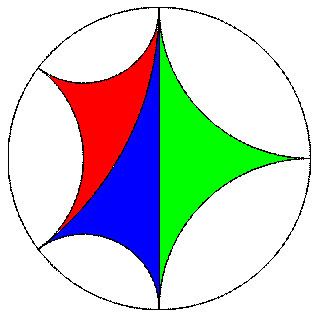 | ||
In hyperbolic geometry an ideal triangle is a hyperbolic triangle whose three vertices all are ideal points. Ideal triangles are also sometimes called triply asymptotic triangles or trebly asymptotic triangles. The vertices are sometimes called ideal vertices. All ideal triangles are congruent.
Contents
Properties
Ideal triangles have the following properties:
In the standard hyperbolic plane (a surface where the constant Gaussian curvature is −1)we also have the following properties:
If the curvature is −K everywhere rather than −1, the areas above should be multiplied by 1/K and the lengths and distances should be multiplied by 1/√K.
Because the ideal triangle is the largest possible triangle in hyperbolic geometry, the measures above are maxima possible for any hyperbolic triangle, this fact is important in the study of δ-hyperbolic space.
Models
In the Poincaré disk model of the hyperbolic plane, an ideal triangle is bounded by three circles which intersect the boundary circle at right angles.
In the Poincaré half-plane model, an ideal triangle is modeled by an arbelos, the figure between three mutually tangent semicircles.
In the Beltrami–Klein model of the hyperbolic plane, an ideal triangle is modeled by a Euclidean triangle that is circumscribed by the boundary circle. Note that in the Beltrami-Klein model, the angles at the vertices of an ideal triangle are not zero, because the Beltrami-Klein model, unlike the Poincaré disk and half-plane models, is not conformal i.e. it does not preserve angles.
Real ideal triangle group
The real ideal triangle group is the reflection group generated by reflections of the hyperbolic plane through the sides of an ideal triangle. Algebraically, it is isomorphic to the free product of three order-two groups (Schwarz 2001).
